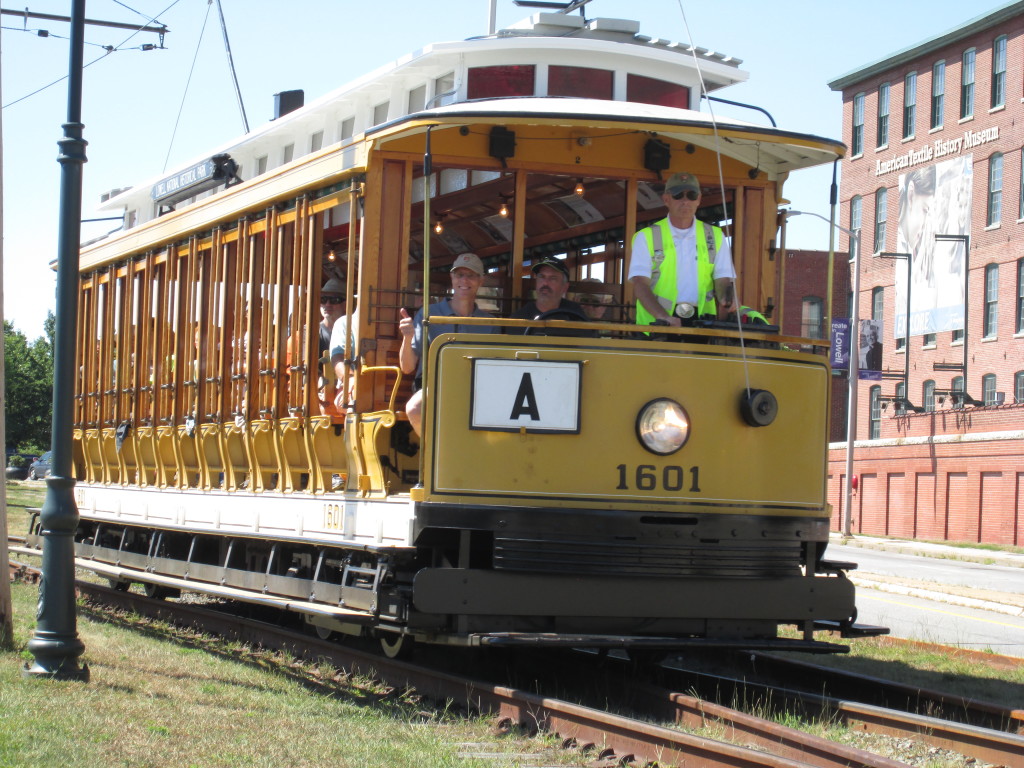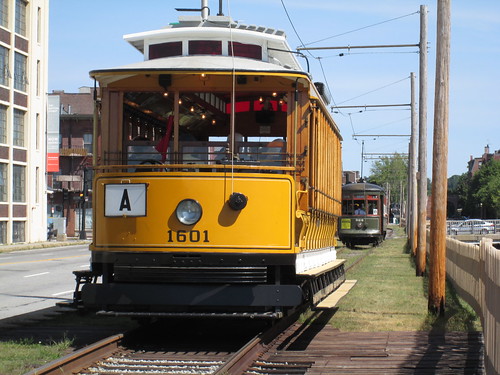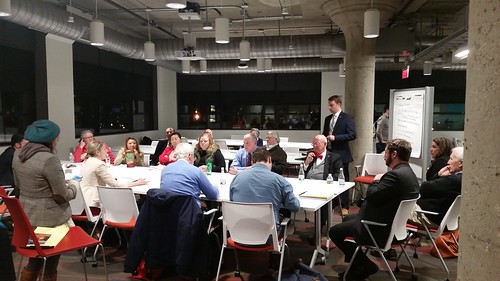Lowell Week in Review: February 14, 2016


Trolley Expansion Dies Quietly
For nearly a decade, there has been talk of a greatly expanded trolley system for Lowell. Conceptually, the project would expand the National Park’s existing 1.5 mile trolley system to connect the Gallagher Terminal with downtown and with UMass Lowell campus centers. A consortium of local partners including the city, UMass Lowell, Lowell National Historical Park, the LRTA, and others, has met for years in pursuit of this objective.
A memo in this week’s city council packet, written in response to a motion asking about the status of the trolley expansion, makes it clear that the project has been taken off life support. In making the case to abandon the trolley project, the memo makes it clear that the cost – $100 million to build and $3 million per year to operate – greatly exceeded the capacity or the willingness of the partners to undertake the effort.
There is a $1.5 million federal grant from several years ago that was appropriated for the trolley system but not yet used. The partners will work with Congresswoman Tsongas to allow for the repurposing of that grant so that it can be spent on other “multi-modal options” for connecting the Gallagher Terminal to downtown and the UMass Lowell campuses in a way that is compatible with “the city’s current projects at South Common and reconstruction of the Lord Overpass.”
Plain Street Realignment
While there aren’t many motions on this week’s council agenda, there are several “motion responses” of substance in addition to the trolley obituary. In reply to a request for an update on the “Plain Street Realignment,” a memo from the city’s Division of Planning and Development states that the final design for that project, part of the 2013 Ayers City Industrial Park (ACIP) Urban Revitalization and Renewal Plan, should be finished this spring and that construction would be able to begin this summer.
Here’s what this is all about: In a stretch of about 50 yards of Plain Street, from the Lowell Connector to the entrance to Target, there are three major intersections but only two traffic lights. One set of lights controls the ramps on the inbound side of the Lowell Connector where they intersect with Plain Street; the other set of lights controls the Plain Street entrance to that Target shopping plaza. Squeezed between those two lights is the intersection of Tanner and Plain Streets. The short distance between these two traffic lights and the resulting traffic backups make access to and from Tanner Street very difficult.
The Tanner Street realignment plan will move that part of Tanner Street that touches Plain Street further to the south (away from the Connector) so that it intersects with Plain Street directly opposite the entrance to Target. This will allow the pre-existing traffic light at that spot to control access to Tanner Street as well as to Target. Tanner Street now runs alongside Lowell Car Wash. This realignment will move it to the other side of Lowell Car Wash so it runs between the car wash and the VFW property. I believe it will require the acquisition of a portion of the VFW property either by purchase or by eminent domain, but that property has been for sale for some time, so presumably the city is already negotiating this with the land owners.
The memo makes mention of obtaining the release of a $250,000 state earmark to pay for the rest of the planning but it makes no mention of the funding for the construction and land takings for the project. So while the job might be ready to begin this summer, it might have to wait until money to pay for it becomes available.
Update on Shot Spotter System and Video Surveillance
A third memo in the council packet is from Police Superintendent Taylor. It addresses two public safety issues: the status of the Shot Spotter acoustic gunfire detection system for which the council appropriated $500,000 in capital funds last year; and an assessment of increased video surveillance capabilities. Taylor explains that the police have thoroughly tested the Shot Spotter system which utilizes multiple directional microphones to detect gunshots which would then allow police to be rapidly dispatched to the location of the shooting. While LPD found the system would work as advertised, it would be leased for $165,000 per year with no option to purchase it outright. He felt that with the incidence of fire arms related crimes down significantly this year from last, the annual cost of the Shot Spotter system plus its limited utility (it detects only gunshots) would not make it the most effective use of the appropriated funds.
Instead, Taylor makes the case for increased surveillance cameras. He proposes using $350,000 of the appropriation to purchase and install up to 48 cameras in the downtown, in city parks, and in “hot spots” around the city. His memo makes a strong case that video cameras are both a strong deterrent to crime – everyone knows they are there – while also providing important evidence in solving and prosecuting crimes that do happen.
The memo seems to invite the council to reallocate the already appropriated capital funds from the Shot Spotter system to the video camera solution.

Discussing Lowell’s Canals as a community resource
Lighting Up the Canals
“Lowell: The Next Initiative” is the name used for the effort launched by Fred Faust and Paul Marion of the Lowell Heritage Partnership (LHP), in collaboration with the City Manager’s office and City Council and with support from Enterprise Bank, to better utilize Lowell’s canals for cultural, recreational, and economic development purposes, held a community meeting this past Thursday at the UMass Lowell Innovation Hub at 110 Canal Street. Those in attendance spent most of the night in smaller working groups on tourism; economic development; and arts, culture and heritage. The next meeting – which is open to everyone – will be held on March 10 (I assume in the same place and at the same time) and then a major gathering will occur in April at the UMass Lowell Inn & Conference Center. That will be a community-wide working group that will discuss the ideas that emerge from the earlier sessions. On April 7, the kick off of this year’s First Thursdays downtown art and business series will feature all the First Thursday events and will culminate with a lighting up of the canals at Lower Locks, between the UMass Lowell Inn and Conference Center and main building of Middlesex Community College. Event partners include the Arts League of Lowell, LHP, UML, MCC, Lowell National Historical Park, Earth Day Committee, Cultural Organization of Lowell, and others.
The first opportunity for people to experience the lighting of the Lowell canals will occur this coming Friday at the opening of Winterfest which extends into Saturday. This year’s Winterfest will be based on Lucy Larcom Park and the highlight will be the newly installed lights shining on the adjacent Merrimack Canal. Check out the city’s Winterfest website for more information and for a complete schedule.
Lowell Judicial Center news
The Lowell Sun’s Rick Sobey reported on Chris Scott’s Column blog earlier this week that the Lowell Judicial Center continues to move forward. DiMeo Construction Company of Providence has been hired as the construction manager and that a ground breaking is supposed to occur this fall. The expected date of completion is now the spring of 2019.
I’ve been told by people who were at this week’s press conference that at seven stories in height, the judicial center will tower above everything else in the area (in a good way). The external construction materials will be granite, glass, and metal, which will further distinguish the building from the red brick mills that sit on either side of Jackson Street.
Tour Bus Relocation OK’d by Conservation Commission
The Conservation Commission this week quietly ruled that the intended site of for parking tour buses visiting Lowell National Historic Park on LRTA-owned land on YMCA Drive does not fall under the state’s Conservation Act because it is not a natural wetland. You may recall that back in December, some on the Conservation Commission were concerned that a past ruling regarding an adjacent condominium complex held otherwise. Seeking consistency, or at least trying to avoid a case of disparate treatment, the commission asked the city’s Planning Department to contact those in charge of the condominium association and obtain their input on this project. That happened and now the project can project, which is a critical part of the overall Hamilton Canal development, can proceed.
Loan Order for Bridge Repairs
The city council will also vote this Tuesday to authorize the borrowing of $2.6 million by the city for the repair of the various canal bridges that are to be granted to the city from Enel Green Power North America. The overall cost of this project is $16.7 million. The city has received a federal TIGER grant of $13.4 million, however, a requirement of that grant is that the city contribute approximately $2.5 million in matching funds. The city’s portion will pay for design and pre-construction expenses, so the money must be raised now. The memo from the city manager in support of this does state that the full $2.6 million will not have to be borrowed.
It’s my understanding that the design work for these bridges will be done in 2017 and that construction will begin in 2018.
Breaking News
The death of Supreme Court Justice Antonin Scalia yesterday sent shock waves through the political world and the immediate controversy over the procedure for selecting his successor is a reminder that elections have consequences. I’ve said that several times this past week in relation to the Massachusetts Supreme Judicial Court which suddenly had three of its seven members announce their retirements. With two of the remaining justices a year away from the mandatory retirement age of 70, Governor Baker will have appointed a majority of that court before his first term even ends. Of course, many past members of the SJC and the U.S. Supreme Court who have been condemned as “liberal activist judges” were appointed by Republican governors and presidents. That just makes the wait for Baker to make his nominations all the more interesting.
Finally, it was -13 degrees this morning. Happy Valentine’s Day.
Thank you for all the interesting updates ..happy valentines day
Wait… So if I read that right, The city is forfeiting a $1.5m land grant rather than make the effort to reappropriate it for another multi-modal connection option? If true, how can we stop such an unwise decision?
Lisa, you’re not reading it correctly (or my writing is unclear). They are working with Congresswoman Tsongas to get permission to use the $1.5mil for multi-modal transportation. They don’t intend to forfeit the money.
I’m sad that the trolley expansion died – while I knew logically it was never going to happen, I was (and am) in love with the idea. Hopefully it will come back in some form, though I don’t have high hopes for that, either.
I whole-heartedly disagree with covering downtown (or anywhere else) with surveillance cameras. Maybe I’m nuts, but as a downtown resident, I just don’t see the need – police are around and visible all the time, disturbances are responded to, and what crime there may be doesn’t seem severe enough to warrant that level of attention.
True story: my wife and I looked at buying a condo on Merrimack Street with roof access. The roof seemed like a nice place to hang out, but when we climbed up to take a look we realized it was in view of at least two (I assume privately owned) security cameras and it was discomfiting to say the least. There were other problems with the place anyway that made us pass on the property, but the cameras certainly didn’t help.
There are other ways to enforce police presence rather than cameras. Foot patrols and police community involvement, while maybe more expensive, are far better for the long-term livability of a neighborhood. At least, that’s how it seems to me.
Great wrap up I was made of several things I was unaware of tanner st for ex .Getting use to using your wrap instead of the Lowell Sun. carol
Jack, I agree with you about the cameras. I think that an over-reliance on technology is a bad route. I am not opposed completely to the use of cameras, but their use should be refined and for a specific purpose, not just an attempt to monitor. I see the need for mobile cameras for monitoring gang activity or setting up cameras to stop illegal dumping in parks, but they should not normally be permanent.
While I do not think that Lowell has a huge crime problem, we would all benefit if the Lowell PD were more present on foot or bike. Other than in downtown and on detail work, I do not see the police out of their cars much, except at a crime scene. It is my belief that our country relies too much on technology to solve issues that should be monitored with intelligence or leg work. There certainly is a need for technology, but it needs to be used intelligently and not just sprayed out there like a shotgun.
I also am saddened about the news of the street car/trolley, although the times from point end of line to end of line seemed quite long for such short distances. I would like to know whether or not a neighborhood improvement tax increase was included in the revenues and costs.